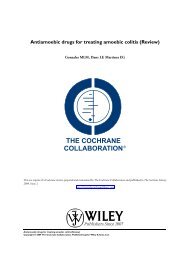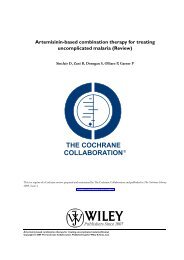Topical treatments for fungal infections of the skin and nails of the foot.
Topical treatments for fungal infections of the skin and nails of the foot.
Topical treatments for fungal infections of the skin and nails of the foot.
You also want an ePaper? Increase the reach of your titles
YUMPU automatically turns print PDFs into web optimized ePapers that Google loves.
There is wide variation in <strong>the</strong> methods <strong>of</strong> treating <strong>fungal</strong> <strong>infections</strong><br />
<strong>of</strong> <strong>the</strong> <strong>skin</strong> <strong>and</strong> toe <strong>nails</strong> <strong>of</strong> <strong>the</strong> <strong>foot</strong> which reflects <strong>the</strong> uncertainty<br />
surrounding efficacy. Uncertainty also extends to <strong>the</strong> optimal period<br />
<strong>of</strong> treatment, appropriate dosage <strong>of</strong> drug <strong>and</strong> frequency <strong>of</strong><br />
application. <strong>Topical</strong> preparations are much less costly than orally<br />
administered anti<strong>fungal</strong> drugs <strong>and</strong> cause minimal adverse side effects.<br />
However, whilst <strong>the</strong>y may be helpful in treating <strong>the</strong> symptoms<br />
in localised <strong>skin</strong> <strong>infections</strong>, uncertainty exists as to <strong>the</strong>ir effectiveness<br />
in <strong>the</strong> complete eradication <strong>of</strong> <strong>the</strong> infecting organisms.<br />
The ideal topical anti<strong>fungal</strong> <strong>for</strong> <strong>the</strong> treatment <strong>of</strong> <strong>fungal</strong> infection<br />
should be fungicidal so that treatment can be <strong>of</strong> short duration, it<br />
should obtain high cure rates, minimise relapses, be conducive to<br />
participant compliance <strong>and</strong> have minimal adverse effects.<br />
Why it is important to do this review<br />
Fungal <strong>infections</strong> <strong>of</strong> <strong>the</strong> feet are treated by dermatologists, general<br />
practitioners <strong>and</strong> podiatrists. A systematic review <strong>of</strong> <strong>the</strong> various<br />
<strong>the</strong>rapies used in <strong>the</strong> topical treatment <strong>of</strong> <strong>fungal</strong> <strong>infections</strong> affecting<br />
<strong>the</strong> <strong>skin</strong> <strong>and</strong> <strong>nails</strong> <strong>of</strong> <strong>the</strong> <strong>foot</strong> will help to in<strong>for</strong>m <strong>the</strong> treatment<br />
approach <strong>of</strong> all <strong>the</strong>se pr<strong>of</strong>essionals.<br />
O B J E C T I V E S<br />
To identify <strong>and</strong> evaluate <strong>the</strong> evidence <strong>for</strong> topical <strong>treatments</strong> <strong>for</strong><br />
<strong>fungal</strong> <strong>infections</strong> <strong>of</strong> <strong>the</strong> <strong>skin</strong> <strong>and</strong> <strong>nails</strong> <strong>of</strong> <strong>the</strong> <strong>foot</strong>.<br />
To establish <strong>the</strong> effectiveness <strong>of</strong> topical <strong>treatments</strong> used <strong>for</strong> <strong>fungal</strong><br />
<strong>infections</strong> <strong>of</strong> <strong>the</strong> <strong>skin</strong> <strong>and</strong> <strong>nails</strong> compared with o<strong>the</strong>r <strong>treatments</strong><br />
or untreated controls.<br />
M E T H O D S<br />
Criteria <strong>for</strong> considering studies <strong>for</strong> this review<br />
Types <strong>of</strong> studies<br />
All r<strong>and</strong>omised controlled studies <strong>of</strong> topical treatment <strong>for</strong> <strong>fungal</strong><br />
<strong>infections</strong> <strong>of</strong> <strong>the</strong> <strong>skin</strong> <strong>and</strong> <strong>nails</strong> <strong>of</strong> <strong>the</strong> <strong>foot</strong>.<br />
Types <strong>of</strong> participants<br />
All men <strong>and</strong> women <strong>of</strong> any age who have a <strong>fungal</strong> infection <strong>of</strong><br />
<strong>the</strong> <strong>skin</strong> or <strong>nails</strong> <strong>of</strong> human <strong>foot</strong> which has been identified by microscopy<br />
<strong>and</strong> growth <strong>of</strong> dermatophytes in culture.<br />
Types <strong>of</strong> interventions<br />
Any programme <strong>of</strong> <strong>treatments</strong> administered topically to treat <strong>fungal</strong><br />
<strong>infections</strong> <strong>of</strong> <strong>the</strong> feet compared with o<strong>the</strong>r <strong>treatments</strong>, placebo<br />
or no <strong>treatments</strong>. All types <strong>of</strong> intervention were considered.<br />
Types <strong>of</strong> outcome measures<br />
Primary outcomes<br />
1. For each trial we calculated <strong>the</strong> treatment failure rate at follow up<br />
from <strong>the</strong> reported mycological results (defined as negative results<br />
on microscopy <strong>and</strong> no growth <strong>of</strong> dermatophyte in culture). In<br />
<strong>the</strong> update <strong>of</strong> <strong>the</strong> review we have only included studies which<br />
subject all <strong>skin</strong> <strong>and</strong> nail samples to KOH (potassium hydroxide)<br />
<strong>and</strong> culture).<br />
2. Quality <strong>of</strong> life as measured by <strong>the</strong> cosmetic acceptability <strong>of</strong> <strong>the</strong><br />
end result to <strong>the</strong> participant, absence <strong>of</strong> itchiness, independence<br />
from medical treatment <strong>and</strong> advice with respect to <strong>the</strong> condition.<br />
Secondary outcomes<br />
1. Measurement <strong>of</strong> recurrence <strong>of</strong> <strong>the</strong> condition in:<br />
(a) <strong>skin</strong> - maintenance <strong>of</strong> cure 12 weeks after initiation <strong>of</strong> intervention;<br />
(b) nail - maintenance <strong>of</strong> cure 36 weeks after initiation <strong>of</strong> intervention.<br />
2. Side effects as measured by <strong>the</strong> frequency <strong>of</strong> reported adverse<br />
events.<br />
Search methods <strong>for</strong> identification <strong>of</strong> studies<br />
Electronic searches<br />
We searched <strong>the</strong> Cochrane Skin Group Specialised Register (January<br />
2005) search strategy in Appendix 1:<br />
We searched <strong>the</strong> Cochrane Central Register <strong>of</strong> Controlled Trials<br />
(CENTRAL) (The Cochrane Library Issue 1, 2005) using <strong>the</strong> search<br />
strategy in Appendix 2<br />
We searched MEDLINE (OVID) (from inception to January<br />
2005) using <strong>the</strong> strategy in Appendix 3.<br />
We searched EMBASE (from inception to January 2005) using <strong>the</strong><br />
following keywords: athlete’s <strong>foot</strong>, tinea pedis, topical treatment<br />
<strong>and</strong> onychomycosis.<br />
O<strong>the</strong>r databases<br />
<strong>Topical</strong> <strong>treatments</strong> <strong>for</strong> <strong>fungal</strong> <strong>infections</strong> <strong>of</strong> <strong>the</strong> <strong>skin</strong> <strong>and</strong> <strong>nails</strong> <strong>of</strong> <strong>the</strong> <strong>foot</strong>. (Review)<br />
Copyright © 2009 The Cochrane Collaboration. Published by John Wiley & Sons, Ltd.<br />
We searched <strong>the</strong> following databases in March 2005 using <strong>the</strong> term<br />
’athlete’s <strong>foot</strong>’ in each:<br />
Science Citation Index <strong>and</strong> Social Science Citation Index within<br />
BIDS<br />
3








